Orchidaceae
The orchids (singular: orchid, [![]()
![]() ˌɔʁçiˈdeːə]) or orchid family (Orchidaceae) are a plant family distributed worldwide. The two testicular root tubers of the orchids (from Greek ὄρχις orchis 'testicle') have given the entire plant family its name. After the composite plants (Asteraceae), orchids are the second largest family among the angiospermous flowering plants. They are considered particularly beautiful, and many consider the orchid to be the queen of flowers. Within the class of angiosperms, they belong to the monocotyledons. About 1000 genera with 15,000 to 30,000 species are recognized by botanists.
ˌɔʁçiˈdeːə]) or orchid family (Orchidaceae) are a plant family distributed worldwide. The two testicular root tubers of the orchids (from Greek ὄρχις orchis 'testicle') have given the entire plant family its name. After the composite plants (Asteraceae), orchids are the second largest family among the angiospermous flowering plants. They are considered particularly beautiful, and many consider the orchid to be the queen of flowers. Within the class of angiosperms, they belong to the monocotyledons. About 1000 genera with 15,000 to 30,000 species are recognized by botanists.
Features
General
The plant taxa of the orchid family differ from other related plant families of the monocotyledonous plants only by a few distinct characteristics. Despite the multiple characteristics found in most orchid species, there are very few that are common to all.
Orchids have the following specific characteristics:
- Orchids usually possess one stamen (gynostemium). The partial or complete fusion of the single fertile stamen and the pistil results in a single flower organ
(plants of the subfamily Cypripedioideae with two stamina and Apostasioideae with two or three stamina). - the pollen grains are clustered together to form the so-called pollinia
- Orchids form numerous very small seeds, which are usually unable to germinate without symbiotic fungi
- the petal of the inner circle of bracts (third petal = petalum), located in the axis of symmetry, is usually clearly different from the others and is called the lip or labellum. It is opposite the fertile stamen (part of the column).
- the flowers are usually zygomorphic (monosymmetrical, dorsiventral). Exceptions are found, for example, in the genera Mormodes, Ludisia and Macodes. The flowers of most orchid species are characterized by the fact that they rotate 180° from bud formation to flower unfolding. This is called resupination. There are also species in which the flower stalk rotates 360° (hyper-resupinated).
Orchids are usually perennial plants and could theoretically continue to grow indefinitely depending on their growth habit (one or more new shoots every year or permanent growth of a shoot). In fact, however, very little is known about the age that orchids can reach.
Growth forms
Orchids can grow in different ways. A distinction is made between the following forms:
- epiphytic, growing on other plants (not as parasites)
- terrestrial, growing on the ground
- lithophytic, growing on rocks or stones
More than half of all tropical species grow as epiphytes on trees. They possess special morphological (velamen radicum, pseudobulbs) and physiological (CAM mechanism) features to cope with the sometimes adverse conditions such as drought and lack of nutrients in the canopy.
Their size is very different, it can be only a few millimetres (Platystele jungermannioides, Anathalis manausesis) up to several metres (Tiger orchid).
Habitus
A distinction is made between monopodially growing orchids, which have a uniform shoot axis that continues to grow at the tip (sometimes also with branching), and sympodially growing orchids, which form successive shoot members with limited tip growth through branching. In monopodially growing orchids, leaves and/or roots serve as storage organs, while sympodially growing orchids form more or less thick single- or multi-limbed pseudobulbs for this purpose. Some orchid genera also form underground storage organs (cormus). Besides the two mentioned growth forms there are also rare variations that do not correspond to the normal scheme of monopodial vs. sympodial growth. For example, many species of the Pleurothallidinae (e.g. Pleurothallis, Lepanthes) do not form pseudobulbs despite sympodial growth, but have fleshy leaves instead.
Roots
Orchids do not form a primary root (taproot), but only secondary roots that arise from the shoot. In their thickness they differ partly quite clearly. In the majority of orchids, the roots have a velamen. In addition to their function as a receptor organ for water and nutrients, they often also serve as an adhesion and holding organ. This is especially important for epiphytic growing species. The shape of the roots depends essentially on where they grow. While the roots of epiphytes that hang freely in the air or those that grow completely into the soil are usually cylindrical, the attachment and holding roots that grow on surfaces have a more flattened shape. In some species, the roots are chlorophyll-bearing so that they can continue to process nutrients even during climatically induced leaf drop. The roots of orchids rarely branch. They have a life span that depends on various environmental factors and is shorter than that of the shoot. New root formation usually occurs with the growth of the new shoot at the end of growing seasons or even during the growing season. In many terrestrial orchid species, storage organs or tuber-like structures form on the roots. In some genera, it is possible for adventitious buds to form on the roots, from which new shoots emerge.
Besides mycorrhiza, which is necessary for embryonic development from a seed, there is also mycorrhiza in the roots. In this case, the fungal filaments grow into the outer or lower cell layers of the roots or rhizomes. The orchids in this case also take up nutrients by digesting fungal parts or excretions. Since the fungus that attacks the protocorm (germinal nodule) does not usually grow outward with the new roots, the mycorrhiza must be formed anew (with the formation of new roots) each year. With sufficient supply of light and nutrients, orchids usually do not rely on this mycorrhiza. Exceptions are the myco-heterotrophic orchids.
Leaves
The majority of orchids have parallel-veined leaves with barely visible cross-links. They usually sit in two rows, alternating on opposite sides of the shoot. Many orchids form only one true leaf, but the attachments of the leaves are also in two rows. The shape of the leaves and leaf tips, the firmness, the colouring and the leaf structure vary greatly.
- Leaf shapes (selection): circular, elliptic, ovate, obovate, kidney-shaped, spatulate, spear-shaped, oblong, bristle-shaped
- shape of leaf tips (selection): rounded, blunt, pointed, tricuspid, notched, incised, unequally sharp-toothed
- Leaf margins: usually smooth, sometimes slightly wavy, only rarely clearly crinkled (Lepanthes calidictyon)
- Leaf structure: with and without petiole
- Leaf firmness: varies from thin and soft to fleshy firm to succulent leaves
- Leaf colour: usually green in various shades (from light to deep dark green), but also completely or partially (undersides) reddish to reddish brown, or chlorophyll-poor or chlorophyll-free completely or partially light to white.
Many species lose their leaves due to climatic conditions in order to form new leaves at the beginning of the next vegetation cycle. While in the majority of these species the leaves are actually only annual, there are also species that shed their leaves only under adverse site conditions or retain them under favourable conditions. There are also species that grow completely leafless (Dendrophylax lindenii). Instead, they have chlorophyll-bearing roots.
Inflorescence
The inflorescences of orchids are usually grape-shaped, on which up to a hundred or more flowers can form, depending on the species. If the inflorescences are branched (paniculate), the racemose form can be found on the outermost branches. In addition to the racemose or panicle-shaped flower shoots, there are also a large number of orchids that are only single-flowered. In some species, several flowers form successively on the same flowering shoot, but never more than one flower is open (e.g. Psychopsis papilio). Inflorescences may arise from any part of the shoot of the orchid. A distinction is made between terminal (at the shoot tip), apical (centrally at the shoot base)) and lateral inflorescences. In most cases, the flower shoots arise from a leaf axil. Due to the direction of growth, the inflorescences of monopodial orchids are always lateral. The individual flowers are always supported by a bract (bract leaf), which is usually inconspicuous.
Bloom
No other plant family has such a spectrum as far as the shapes and colours of the flowers are concerned as the orchid family. The size of the flowers varies from a few millimeters (example Lepanthes calodictyon) up to 20 centimeters and more per flower (example Paphiopedilum hangianum). The colour spectrum ranges from delicate white to shades of green and blue to strong red and yellow. Many of the orchid flowers are multicoloured.
Except for some genera (for example Catasetum), the trifoliate flowers of orchids are hermaphroditic. The perianth consists of two circles. There is an outer perianth circle consisting of three sepals and an inner perianth circle consisting of three petals. The petals may be free or fused together to some degree. In some orchid genera, such as the subfamily Cypripedioideae or Acriopsis, the lower two sepals are completely fused. The petal of the inner perianth, located in the axis of symmetry, is usually distinctly different in size, colour and shape. It forms the lip (labellum) of the orchid flower. In many orchids the lip is extended on the back to a tubular to baggy structure, the so-called spur (examples Aeranthes, Aerangis). It either contains nectar or is empty. Other species form a "shoe" from the lip (for example, the genera of the subfamilies Cypripedioideae). In addition, the column (gynostemium) and the ovary are essential parts of the flowers. In the basic structure one distinguishes monandrous (one fertile stamen, examples Cattleya, Phalaenopsis) and diandrous (two fertile stamens, examples Paphiopedilum, Cypripedium) orchids. The ovary is inferior in orchids. The other parts of the flower (sepals and petals, column, lip) are completely fused with it and stand above it. As a rule, the ovary is only very narrow and swells only after pollination (formation of the seed capsule). With the exception of some genera (e.g. Cycnoches, Mormodes), the flowers of orchids are bilaterally symmetrical (zygomorphic). This means that you can put a mirror axis through the middle of the flower, and only one (monosymmetrical).
A central role in the reproduction of orchids is played by the special pollen accumulations. The pollen formed by the stamens are glued together in two loose or tight bundles (pollinia). These two clumps hang on a more or less long shaft with an adhesive disc (viscidium), it adheres to the pollinator by a fluid from the adhesive gland (rostellum).
Fruits
Almost all orchid fruits are capsules. They differ significantly in size, shape and color. Epiphytes tend to have thicker fruits with fleshy walls, terrestrial species often have thin-walled dry fruits. There are triangular, roundish with a more (to 9) or less (to 3) number of ribs, or beaked fruits. Some are hairy or spiny or have a warty surface. The fruits develop from the ovary, which is already formed in the bud stage at the base of the flower and consists of three carpels. When ripe, most orchid fruits burst open lengthwise without separating completely at the tip. Usually three or six longitudinal clefts are formed, in some cases only one or two. Almost always, the seeds are scattered dry in the process.
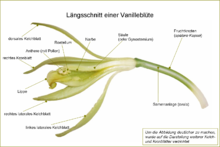
Vanilla planifolia Flower analysis

Close-up of a Phalaenopsis flower
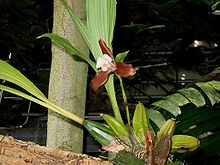
Sympodial: Lycaste xytriophora with pseudobulbs
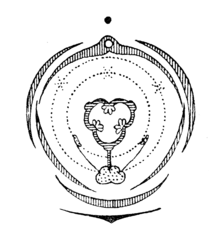
Flower diagram of Orchis
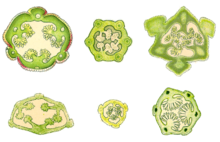
Capsule cross sections
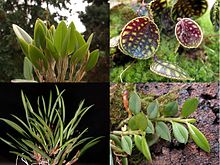
Leaf shapes of different orchids

Detail of a branched inflorescence of Oncidium flexuosum

1: labellum, 2. petals, 3: sepals

Monopodial: Vanilla planifolia

Cattleya warscewiczii
Propagation
Orchids can be propagated in different ways. There is propagation by seed as well as vegetative propagation. Under artificial conditions, propagation by meristems is also possible.
Seeds
Almost all orchids have tiny seeds. Each plant produces hundreds of thousands to millions of seeds in a seed pod. Because of their small size, orchid seeds are reduced to nothing more than a pod and the embryo within it. Unlike other seeds, they lack the nutritive tissue or endosperm necessary for successful germination. Only in a few genera is this still present (e.g. Bletilla). Orchids are therefore dependent on a symbiosis with fungi. In this process, known as mycorrhiza, the embryo that begins germination is infected by the penetration of fungal filaments into the seed. The embryo obtains nutrients (mycotrophy) through this connection by digesting parts of the fungal body or excretions of the fungus. Once the seedling is capable of photosynthesis, this takes over supplying the plant with nutrients and mycotrophy is no longer necessary for further development. However, there are some orchid species that depend on mycotrophy for their entire life due to the absence of chlorophyll or its presence in insufficient amounts (ex. coralroot). This concerns all completely myco-heterotrophic species.
While the majority of orchids scatter dry seeds, there are some genera (e.g. Vanilla) in which the seeds are surrounded by a moist mass.
Pollination
In nature, orchids are mainly pollinated by insects (e.g. ants, beetles, flies, bees, butterflies), but also by birds (e.g. hummingbirds), bats or frogs. In some cases, species-species relationships (e.g. Drakea glyptodon and Zapilothynus trilobatus or the native Orchis papilionacea and Eucera tuberculata) or genus-genus relationships (e.g. the orchid genus Chloraea is pollinated by bees of the genus Colletes) have developed. This specialization is usually unilateral, as no insect species is restricted to pollinating a single orchid species. Within the family, however, there are some genera in which some or all species reproduce asexually by self-pollination. These include the genera Apostasia, Wullschlaegelia, Epipogium and Aphyllorchis. The species Microtis parviflora is also known to self-pollinate in the absence of pollination by ants. However, the pollinators are unknown or little studied in a large number of orchid genera.
Orchids are usually not self-sterile.
In nature, hybrids between two related species (rarely across genera) are sometimes created by pollinators; these are called natural hybrids.
Pollination mechanisms
Compared to other flowering plants, it is striking that non-tropical orchids, for example, often do not offer a reward in the form of food, but achieve their goal through mimicry or deception. If rewards are offered, they often do not consist of food, but of scents (for example, sex attractants for insects as is the case with some wasp species) or wax.
The evolutionary development of different flower forms resulted in an increasing specialization on certain pollinator groups and thus also on the way the flowers are pollinated. Some pollination systems and mechanisms are explained below.
- "Tube flowers." The structure of the flower is such that the pollinator must enter a "tube" below the column, and thus the pollen is usually attached to the insect's back. Sometimes also to the head or to the underside. (Ex. Cattleya)
- "Keyhole flowers." The flower is constructed in such a way that the pollinator must adopt a very specific position in or on the flower, where the pollen is usually attached to the pollinator's head or sometimes even directly to its beak or proboscis. (Ex. Epidendrum)
- "trap flowers": In this category, a distinction is made between hinged or tipped traps (Ex. Porroglossum, Bulbophyllum) and cup traps (genera of the subfamily Cypripedioideae). All these traps have in common that they force the pollinators to crawl through a certain exit, where they usually graze the stigma first and then the pollinia, which are attached to them. Thus, self-pollination is prevented on the first pass.
- "pheromone flowers": The shape of the flower resembles a female insect and may also emit pheromones. This attracts male insects willing to mate and pollination takes place during the supposed attempt at copulation. Pseudocopulation is a variant of mimesis and is known in the native genus Ophrys.
- "Alarm florets": The flowers emit alarm substances either of a supposed prey (e.g. the honey bee) or produce the plant's own signal substances, which normally indicate that a herbivore is threatening the plant (e.g. a butterfly caterpillar). Female wasps and hornets in particular are fooled by this and respond by pouncing on the orchid flower in anticipation of easy prey.
In orchids, the pollen is clustered into pollinia with attached viscidia (viscidium = adhesive disc, adhesive body) (the Cypripedioideae, for example, are an exception). This makes it possible to position the pollen packages exactly, so that it is possible for pollinia of different species to be attached to one pollinator without false pollination. Up to 13 attachment sites have been found on different bee species (Euglossinae). In contrast to other flowering plants, orchid pollen does not serve as food.
The epiphytic Chinese orchid Holcoglossum amesianum uses an unusual pollination technique: the anther cap opens and the male stamen filaments actively turn almost 360 degrees towards the female stigma without any aid. The pollen grains attached to the flexible stamen filament are subsequently released when they touch the stigma, allowing self-fertilization to occur. It is assumed that this technique is an adaptation of the orchid to its dry and insect-poor habitat, which is possibly not so rare in plants of comparable biotopes. The already known self-pollination of the bee-ragwort (Ophrys apifera) follows a similar pattern.
Orchids and Magnificent Bees: The best-studied floral scents are those of Stanhopea and Catasetum, which smell pervasively of pineapple, vanilla, cinnamon, cumin, or menthol, and attract male magnificent bees, which neither pollinate nor attack the flowers, but merely seek to collect the oil produced by the plant and use it for their courtship. There are innumerable species of magnificent bees as well as orchids, each of which belongs to the same species.
Vegetative propagation
Different species have the possibility to reproduce vegetatively by forming stolons (e.g. Mexipedium xerophyticum), tubers (e.g. Pleionen) or peduncles (adventitious plants; e.g. Phalaenopsis lueddemanniana). The resulting plants are genetically identical.
Meristeme
Propagation via meristems is mainly done in commercial horticulture for the production of large quantities of orchids for cutting as well as for sale as potted plants, which can often be purchased in garden centres or DIY stores. Large producers can be found mainly in the Netherlands or in Thailand. It is also the only way to produce identical offspring in large quantities from certain clones, for example award-winning plants, which may also bear the same cultivar name. In commercial horticulture, however, there is an increasing tendency to use in vitro sowing of orchid seeds and clustering by hormone administration to meet the demand for mass propagation.

Paphiopedilum godefroyae
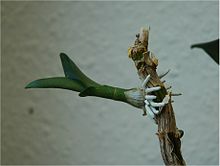
Formation of children in Dendrobium spec.

Pollinia of a Phalaenopsis

Sword-leaved woodland bird (Cephalanthera longifolia)
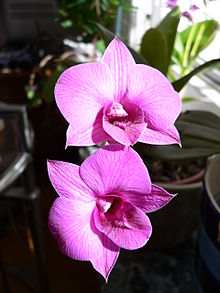
Dendrobium bigibbum
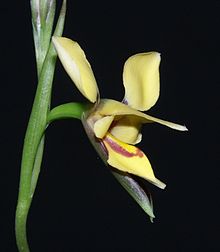
Diuris drummondii
Questions and Answers
Q: What are orchids?
A: Orchids are a large family of flowering plants, the Orchidaceae.
Q: What type of plants are orchids?
A: Orchids are herbaceous monocots.
Q: How many species and genera of orchids are there?
A: There are between 22,000 and 26,000 species in 880 genera.
Q: Where can orchids be found?
A: Orchids can be found in almost every country in the world except for Antarctica.
Q: Why do people grow orchids?
A: People grow orchids for show, for science, or for food (for example, vanilla).
Q: Do all orchids have the same way of pollination?
A: No, some orchids have very special ways of pollination.
Q: What are myco-heterotrophs?
A: Many orchids are myco-heterotrophs, which means their roots need fungi to break down organic material for them to absorb.
Search within the encyclopedia